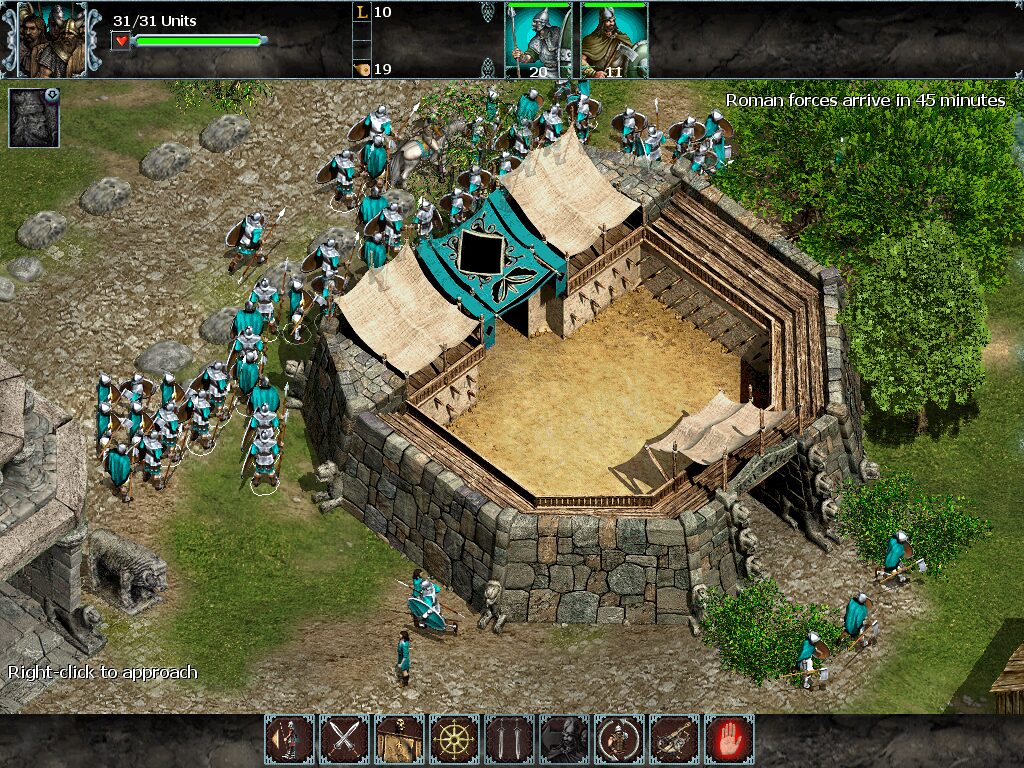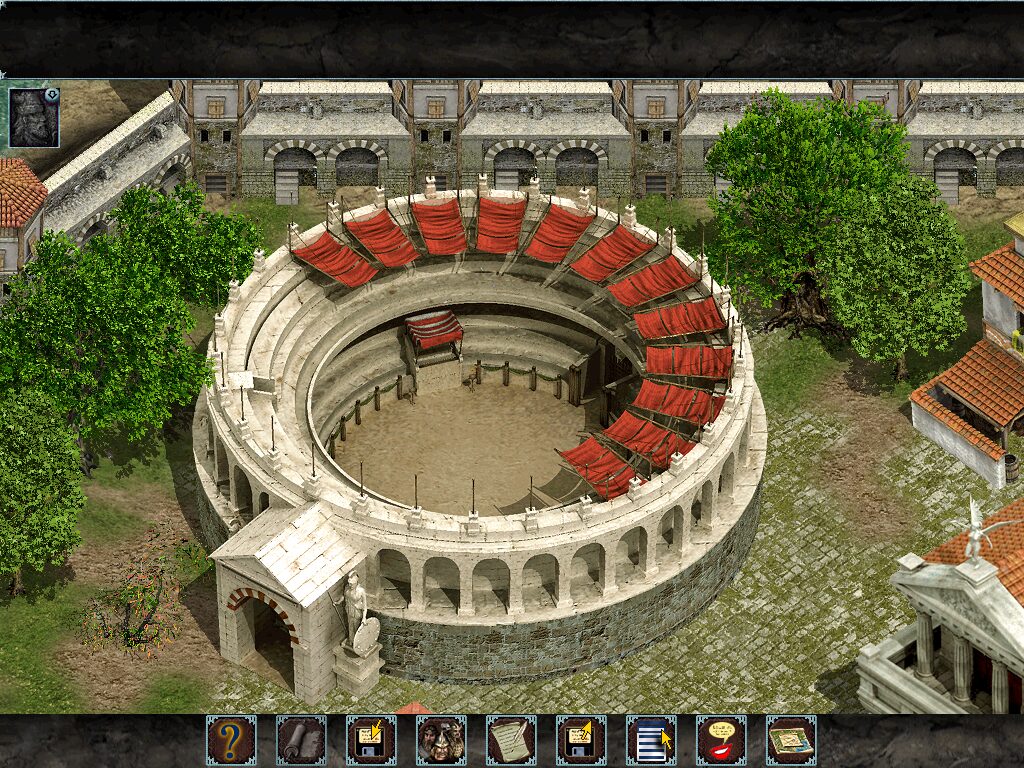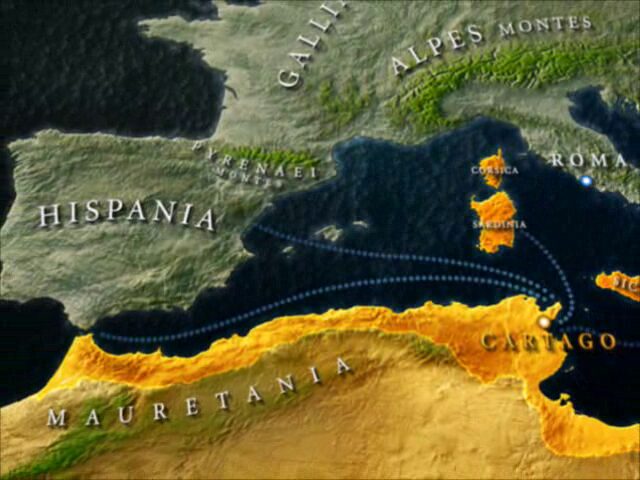Retro Replay Review
Gameplay
Nemesis of the Roman Empire emphasizes tactical warfare over base building, making each encounter a thrilling test of battlefield strategy. Instead of gathering wood or constructing barracks, you vie for control of pre-built villages, forts, and resource points scattered across the ancient Mediterranean landscape. Holding these structures yields vital resources such as food and gold, which you must use wisely to reinforce and replenish your armies.
(HEY YOU!! We hope you enjoy! We try not to run ads. So basically, this is a very expensive hobby running this site. Please consider joining us for updates, forums, and more. Network w/ us to make some cash or friends while retro gaming, and you can win some free retro games for posting. Okay, carry on 👍)
Unit formations and terrain play a pivotal role in every skirmish. Infantry phalanxes can hold choke points in mountain passes, while cavalry flanks excel on open plains or along coastlines. Recruiting hero units adds a layer of RPG-style progression, as these commanders grow in strength and grant unique bonuses to nearby troops. Learning to leverage each faction’s special units—like the Iberian javelinmen’s ranged harassment or Carthaginian elephants’ devastating charge—is key to mastering the game.
The inclusion of two extensive adventure campaigns deepens the tactical experience. In the Carthaginian campaign, you follow Hannibal’s daring Alpine crossing, managing limited supply lines and ambush tactics against Roman legions. The Roman campaign flips the perspective, tasking you with defending the Republic and countering Hannibal’s advances. Beyond the story modes, skirmish matches support up to eight players (human or AI), and a built-in map editor lets you craft custom battlefields to challenge friends or the CPU.
Graphics
Released in the early 2000s, Nemesis of the Roman Empire delivers a solid visual presentation that holds up for its era. The game uses a sprite-based engine combined with 3D terrain, giving unit sprites depth of field as they move across hills, valleys, and river crossings. While not cutting-edge by today’s standards, the graphics are rich with period detail—from intricately drawn Roman standards to the distinctive red cloaks of Gallic warriors.
Environmental variety enhances immersion, with lush Mediterranean forests, rocky Alpine passes, and sun-baked North African deserts each rendered in distinct color palettes. Weather effects, such as drifting snowflakes during Hannibal’s march or dust clouds kicked up by chariot charges, add atmospheric flair and subtle tactical considerations—visibility can be reduced and units may tire more quickly in harsh conditions.
Animations, though somewhat limited in frames compared to modern titles, convey the weight and momentum of phalanx advances or elephant charges. Sieges look especially impressive, with catapults hurling boulders and walls crumbling realistically under concentrated fire. On widescreen monitors, the UI scales cleanly, and the minimap provides essential situational awareness without cluttering the battlefield.
Story
The dual-campaign structure offers two contrasting narratives that bring the Punic Wars to life. As Carthage’s commander, you retrace Hannibal’s legendary march, negotiating treacherous Alpine terrain and forging alliances with local tribes. The campaign’s mission design emphasizes asymmetric challenges—overcoming supply shortages, side-stepping stronger Roman forces, and deploying lightning raids on vulnerable settlements.
Switching to the Roman side, the story unfolds from the Republic’s perspective, highlighting your role in counter-offensives and major engagements like the Battle of Cannae. This thread explores the political tension in Rome, the Senate’s debates over strategy, and the heroism of figures such as Scipio Africanus. Cutscenes and in-game briefings blend historical context with narrative flair, helping you feel personally invested in each campaign goal.
While the prose occasionally leans on broad-strokes historical exposition, the missions themselves are paced to maintain tension and variety. Whether raiding Iberian villages as Roman legions or leading Trojan mercenaries for Carthage, the scenarios challenge you to adapt your tactics and immerse yourself in the era’s complex geopolitical dynamics.
Overall Experience
Nemesis of the Roman Empire stands out for its tight focus on tactical warfare within a richly detailed ancient setting. By forgoing traditional base building, it channels player attention toward maneuver warfare, reconnaissance, and the precise timing of reinforcements. This makes each match feel more like a classical wargame and less like a resource-management sim, appealing to strategy purists and history enthusiasts alike.
The game’s AI can be ruthlessly efficient, flanking overextended units or reinforcing chokepoints at just the right moment. While occasionally predictable at lower difficulties, the AI becomes a formidable foe in skirmishes and late-game campaign missions. Multiplayer matches further elevate replayability, as human opponents exploit unpredictable strategies and coordinate joint assaults.
Though some modern conveniences—like streamlined pathfinding and advanced AI scripting—are absent, the core experience remains deeply rewarding. The scenario editor extends the game’s lifespan, and the passionate modding community has released balance tweaks and graphical upgrades over the years. For anyone fascinated by ancient military tactics and epic narratives of Carthage versus Rome, Nemesis of the Roman Empire offers a compelling journey back to one of history’s greatest conflicts.
 Retro Replay Retro Replay gaming reviews, news, emulation, geek stuff and more!
Retro Replay Retro Replay gaming reviews, news, emulation, geek stuff and more!









Reviews
There are no reviews yet.